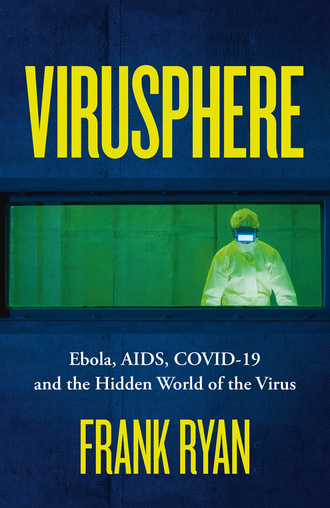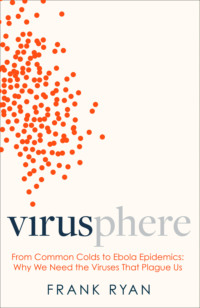
Полная версия
Virusphere
Bugs, such as bacteria and viruses, do not think. No more do they have feelings. Their behaviour among themselves, and in relation to their hosts, is driven by a mixture of happenstance and the fundamental mechanisms of evolution. Symbiosis is not about Mr Friendly Guy who shakes the hand of Ms Friendly Lady and everything is hunky-dory from then on. It is about survival in what Darwin called ‘the struggle for existence’. In 1878 a professor of botany in Berlin, called Anton de Bary, defined symbiosis as ‘the living together of differently named organisms’. A modern interpretation might rephrase his definition as ‘living interactions between different species of organisms’. The interacting partner species are called ‘symbionts’ and the interaction as a whole is called the ‘holobiont’.
While symbiosis includes parasitism, which is defined as a symbiotic interaction in which one or more of the partners benefits from the partnership at the expense of another, symbiosis also includes commensalism, where one or more partners gains without detriment to the others; and it also includes mutualism, where two or more of the interacting partners gain from the partnership without harm to the other partner, or partners. It is important to grasp that mutualism often begins as parasitism – indeed in nature many relationships involve situations somewhere between the extremes of parasitism and mutualism. This broader umbrella of living interactions offers the necessary scope for understanding the enormous variety of living interactions, involving microbes and their hosts, in nature. It allows us to compare and contrast a bacterium, E. coli, with a virus that also has a predilection for the human gut: the so-called winter vomiting bug, known as the norovirus.
The norovirus is the commonest cause of gastroenteritis in the world, familiar to most of us with its unpleasant manifestations of diarrhoea, vomiting and stomach cramps. It is extremely contagious by the faecal-oral route, whether through contaminated food or water, or direct contact contamination from another sufferer. Once again, we humans appear to be the only host. This, in turn, means that we are the natural reservoir in nature of the virus. Symptoms usually develop some 12 to 48 hours after exposure to infection, often with a low fever and headache. The gut irritation is rarely severe enough to provoke the bloody diarrhoea that is sometimes seen in dysentery, and recovery usually follows within a few days. Since the condition is usually self-limiting, diagnosis tends to be made on the basis of symptoms alone, especially when it occurs during a local recognised outbreak. No specific treatment is usually necessary, although sufferers may be helped by increasing fluid intake to avoid dehydration, together with non-specific anti-fever and anti-diarrhoeal medication. Laboratory confirmation is not usually necessary although public health authorities may sometimes make use of it for contact tracing purposes.
Prevention is the judicious policy, through careful hand-washing and disinfection of potentially contaminated surfaces. Unfortunately, alcohol-based hand sanitisers of the sort dispensed in hospitals are, reportedly, ineffective.
Noroviruses comprise a genus within the family of calciviruses, so-called because they have cup-like depressions in their capsids and so were named after the Greek word calyx, which means a cup or goblet. Since they cannot currently be cultured in the usual laboratory media, the single species is divided into six genetically distinct ‘genogroups’, which infect mice, cows, pigs and humans. The human genotypes are extremely infectious even from minute numbers of the virus, so much so that it has been calculated that a single tablespoonful of diarrhoeal effluent from an infected individual would contain enough viruses to infect everyone in the world many times over. But this is no cause for alarm. Thankfully there is rather more to infectious spread than such theoretical extrapolations. A more practical consideration is the fact that affected individuals can remain infectious for several days after the symptoms have settled. This means that they might feel well enough to return to normal life, including work premises, when they are still capable of passing on the virus. It might also contribute to the tendency for outbreaks to occur in closed communities, such as hospitals, cruise ships, schools and residential care homes, where communal food preparation, and common dining areas, make transmission of the virus more likely. Readers may be surprised to learn that, in spite of the relatively mild nature of the illness, the ease of transmission, combined with the prostration of the vomiting and diarrhoea, has led to the norovirus being classed as a Category B bio-warfare agent.
Globally it is estimated that norovirus infects some 685 million people a year, most of whom go on to make a full and speedy recovery. Unfortunately, in a small minority, it can result in a life-threatening illness, with some 200,000 or so deaths worldwide each year. Children under the age of five years are most susceptible, especially in developing countries, where it causes as many as 50,000 paediatric deaths annually. It is worrying that the number of reported outbreaks has been rising since 2002, warning health authorities, if they weren’t sufficiently alarmed already, that we need to treat the norovirus as a dangerous ‘emerging infection’, and one that may be evolving even more highly infectious strains.
The causative virus is globular in shape and between 20 and 40 nanometres in diameter. This means that the norovirus is somewhere between a hundredth and a fiftieth the size of the E. coli bacterium. Viruses lack the enclosing cell wall seen in bacterial, or indeed human, cells. But under the powerful magnification of the electron microscope we see that the norovirus possesses an icosahedral capsid, which encloses and protects the viral RNA-based genome. E. coli, like all bacteria, and indeed all cellular forms of life, has a DNA-based genome.
If we compare and contrast the bacterial and viral genomes, we come across gargantuan differences between bacteria and viruses at every level of their structure and organisation. The E. coli genome is coiled into a single, very lengthy circle of DNA that is attached to the inner aspect of the bacterial cell wall at a single point. This bacterial genome contains roughly 4,288 protein-coding genes, as well as coding sequences for other key metabolic functions involved with the handling of gene expression. This is comprehensive enough for the bacterium to store the memory of its genetic heredity as well as to allow it to carry out numerous internal metabolic functions involved in its internal physiology and biochemistry. One such key function is the control of the processes involved in its budding pattern of reproduction, to produce daughter bacteria.
When compared to the bacterial genome, the norovirus counterpart is frugal in the extreme. The viral genome comprises regulatory regions at either end of a compact linear string of RNA, which codes for a minimum of eight proteins, two of which code for the protein structures of the viral capsid, and six concerned with viral replication. A key difference between the bacterium and the virus is that the bacterium has all it needs to reproduce itself, but the virus can only replicate to produce daughter viruses by making use of the genetic and biochemical properties of its cellular host. In the case of the human strain of norovirus, these genetic and biochemical properties are those of the human target cell.
The norovirus genome codes for a singular aggressive viral protein known as the ‘protein virulence factor’, or VF1. This menacing entity localises to the human mitochondria during infection with the virus, where it antagonises the infected person’s innate immune response to the virus. While some viruses are capable of commensalism or even mutualistic interactions with their hosts, we see little evidence for this in the norovirus. Its symbiotic interaction with humans appears to be exclusively parasitic. Unlike the bacterium, it has no genes devoted to nutrition, or to internal metabolic pathways, since, unlike the bacterium, it has no internal metabolic pathways. Its genome is designed to take advantage of the physiology, metabolic pathways, genetic pathways, and even the very locomotion and life-style patterns of human behaviour in order to replicate itself and transmit its contagion as widely as possible.
So now we see that viruses are not fluids or poisons. They are organisms that follow a wide range of symbiotic interactions, each virus usually associated with a highly specific host, a tiny minority of which happen to be human. They are clearly very different in size, genomic organisation and life-cycle patterns to bacteria. The fact that most viruses do not possess their own internal metabolic processes does not imply that viruses do not utilise metabolic processes. On the contrary, viruses take advantage of their host’s metabolic pathways. This is why it is a mistake to think of viruses in isolation from their hosts. Outside their hosts viruses are biologically inactive: but this does not mean that they are inorganic chemicals.
Outside the target cells of their hosts, viruses have evolved stages that are somewhat equivalent to suspended animation. This stage is well-suited to being ejected in the aerosol created by a cough or a sneeze, or excreted in faeces, or in sexual secretions, or surviving being transferred by a secondary carrier, such as a biting insect or a rabid dog; or in the case of plant viruses, being carried to new hosts on the wind, or through water, or through a miscellany of other avenues of transmission, to find new hosts. Only when they enter into their obligate symbiotic partnership with the new host do we witness viruses behaving with the genetic and biochemical subtlety and efficiency we might expect of biological organisms.
The norovirus is no exception to such symbiotic evolutionary behaviour. So specific is the virus in its symbiotic interaction with its human host that different human-associated viral genotypes have affinities for specific ABO blood group proteins on cell membranes, these protein ‘receptors’ binding with one of the two proteins of the viral capsid as an integral step in the infectious process. On passing into the bowel, the virus has a predilection for the upper small bowel, or jejunum. How, exactly, the virus then penetrates the intestinal wall is not fully understood, but it would appear that it preferentially infects the immune lymphoid follicles in the gut wall, which are known as Peyer’s patches, while also searching out a type of intestinal cell, known as H-cells. After making its way through the gut wall, the virus is identified as alien by the innate immune defences of the gut, which might be just fine as far as the virus is concerned, since these may be its target cells. Whatever the target cells, we can anticipate that the virus will hijack their genetic and metabolic pathways in order to replicate itself, thus establishing its cycle of infection and multiplication, generation after generation.
Since we don’t yet have suitable tissue cultures or animal models to study the norovirus, we are not in a position to examine the ways in which it provokes the vomiting and diarrhoea, which play a key role in spreading the virus far and wide throughout the world. Currently there is no preventative vaccine, but trials of an oral vaccine are taking place as I write. Let us cross our fingers and hope that these trials are rewarded with an early success!
6
A Coincidental Paralysis
In the summer of 1921 the 39-year-old Franklin D. Roosevelt fell overboard from his yacht on the Bay of Fundy, a beautiful if freezing inlet between the eastern Canadian provinces of New Brunswick and Nova Scotia. The following day he was tormented by pain in his lower back and then, as the day progressed, he felt his legs grow increasingly weak until they could no longer sustain his body weight. This was the onset of Roosevelt’s poliomyelitis, at this time known as ‘infantile paralysis’. Poliomyelitis is caused by a virus that goes by the same name. In 1921 doctors were limited in their knowledge of the poliovirus, or indeed viruses as such. They might, however, have known that the virus did not infect Roosevelt while he was struggling in the cold water – the only infectious source of poliomyelitis virus is another person who has already contracted it. Once again, we are looking at an exclusively human reservoir. Moreover, the paralytic disease has an ancient pedigree.
Infantile paralysis was familiar to physicians in the time of the pharaohs of Egypt, since the effects of the disease were painted, with stunning accuracy, on the walls of their tombs. In 1921, as indeed today, there was no cure for the paralytic effects of the virus once it had afflicted a victim. Fortunately, Roosevelt was gifted with an extraordinary vitality and courage, enabling him to overcome the lifetime of paralysis that would result from his illness. It is to his credit that despite this handicap he became the 32nd President of the United States and he continued to serve the American people for an unprecedented four terms in office.
Viruses do not follow our human notions of rules and so they are apt to surprise us. One such surprise is that those viruses that replicate primarily in the gut – the so-called ‘enteroviruses’ – do not cause the usual symptoms of gastroenteritis. Instead, the viruses that do cause gastroenteritis are a miscellaneous group with members coming from widely different viral families. Of course, these include the genus of noroviruses within the family of calciviruses. Another group of gastroenteritis-associated viruses are the rotaviruses, a genus within the family of reoviruses, which cause vomiting, diarrhoea and fever in babies under the age of two years. Other similar offenders include adenoviruses, coronaviruses and astroviruses. We are sometimes inclined to joke about the clinical effects of gastroenteritis, but the truth is that this is a distressing condition in people of any age. Moreover, in less developed countries, gastroenteritis is one of the commonest causes of death in children, a tragic situation complicating poor hygiene and contaminated water supplies. As we might anticipate, these illnesses are transmitted by the faecal-oral route.
The ‘enteroviruses’ are also transmitted by the faecal-oral route and the viruses also replicate within the intestine, but curiously they do not present with the typical fever, vomiting and diarrhoea that typifies gastroenteritis. Instead they cause less predictable and often complex patterns of illness that affect various organs and tissues, for example, the brain and meninges, or the heart, skeletal muscles, skin and mucous membranes, the pancreas, and so on. The most familiar of this strange gamut of enterovirus-linked illnesses is poliomyelitis. All three ‘serotypes’ of the poliovirus, which have slight differences in their capsid proteins, are ‘enteroviruses’ within the family known as the picornaviruses. We might recall that these belong to the family of very small RNA-based viruses that includes the rhinoviruses. A cardinal feature of enteroviruses is that they are resistant to acid, so they can pass through the human stomach to replicate further down the alimentary tract. The poliovirus was the first of the enteroviruses to be discovered, earning its finders – Enders, Weller and Robbins – a Nobel Prize in 1954.
We should not be too surprised to discover that humans are the exclusive host of the poliovirus. The individual virion is a mere 18 to 30 nanometres in diameter. Under the electron microscope it has a capsid with the familiar icosahedral symmetry, which encloses a relatively simple RNA-based genome. In the small intestine, the virus binds to a specific receptor molecule in the lymphoid tissues of the pharynx and the ‘Peyer’s patches’ of the gut. Here the virus hacks its way into the interior of the cells, where it takes over the genetic processes to convert the cell into a factory for manufacturing daughter viruses. The daughter viruses are released through rupture of the infected cell, after which they re-invade neighbouring cells and repeat the process.
All of this sounds a trifle horrific and even potentially deadly. But in reality the great majority of individuals infected by poliovirus show little or no signs of disease other than, perhaps, a mild looseness of the bowels. But the stools of an infected individual will now be swarming with virus, which will be passed on to contacts through the faecal-oral route. Polio characteristically moves through populations in epidemic waves, with most of the infected unaware that they have encountered the virus. Only in a tiny minority does the virus make its way to the anterior horn nerve cells in the spinal cord, where infection and subsequent death of the nerve cells gives rise to the paralysis we saw in President Roosevelt. Bizarre as it might seem, the infection of the nerve cells appears to serve no purpose as far as virus transmission or evolutionary pathways are concerned. Indeed, this most dreaded complication of poliomyelitis appears to be coincidental.
The incubation period of poliovirus infection is usually a week to two weeks and, in the minority that show symptoms of infection, this involves a minor malaise, fever and a sore throat. These reflect the virus entering the bloodstream and will usually resolve without requiring any treatment and with no long-term consequences. Only in a small minority of those infected does polio give rise to a more severe illness. The onset is usually abrupt with headache, fever, vomiting – in some this may be accompanied by the neck stiffness typical of meningitis. Even still, the majority of symptomatic cases will go on to make a good recovery. But in the tiny but highly significant minority the paralysis of poliomyelitis sets in.
Paralytic poliomyelitis gets its name from the Greek polios for ‘grey’ and muelos, for marrow. This derives from the fact that the paralysis results from destruction of the grey marrow of the anterior horns of the spinal cord, which contain the cell bodies of the nerves that supply the muscles of arms, legs, chest and remainder of the trunk. The death of those cell bodies in the spinal cord causes a floppy style paralysis of the affected muscles, which is usually apparent within two or three days of the onset of the disease. In children affected by paralysis, this will have secondary long-term effects on limb growth and development. Bulbar poliomyelitis, a similar infection, causes damage to the nerve bodies of the cranial nerves, which results in paralysis of the pharynx and possibly accompanying difficulty with the muscles involved in breathing. This dreadful complication is why, before the advent of vaccination, some unfortunate patients ended up having to be supported by ‘iron lungs’.
We do not know why this unfortunate minority of infected individuals develop serious disease, including paralysis, from the poliovirus. There is some evidence that the virus gets into the central nervous system more commonly than is suggested by clinical signs. Indeed, as we shall see, this pattern of unwanted penetration into the central nervous system can feature in illnesses caused by other enteroviruses. One wonders if some genetic propensity might perhaps play some role, but it may be no more than bad luck. As we saw above, this pattern of paralysis in children, with its effects on limb growth, was recognised in the wall paintings of the tombs of pharaohs from Ancient Egypt. How puzzling then that such an ancient and easily recognisable disease was unfamiliar to European doctors until the latter years of the nineteenth century, when the first epidemics began in the cooler climates of industrialised Europe and the United States!
Such has been the dramatic success of vaccination programmes, using live attenuated viral vaccines taken by mouth, that polio has been largely eliminated from developed countries. In 2018, according to the Global Polio Eradication Initiative, the disease is now endemic in just three countries: Afghanistan, Nigeria and Pakistan. But, given the ease and extent of modern travel, we cannot rest assured until this historic and maiming disease is completely eradicated in these remaining pockets of potential contagion.
While poliomyelitis is now approaching global control, it is not the only enterovirus to afflict humanity. Other members of this virus family are still commonly encountered in developed countries, including viruses that can be baffling in their presentations and clinically unpredictable in the course of their illnesses. Perhaps the best known of these are the Coxsackie B viruses, which sometimes present with a condition known to doctors as epidemic pleurodynia. Also known as ‘Bornholm disease’, after the Danish island where it was first recognised, this can present as severe chest pain arising from inflammation in the intercostal muscles of the chest wall. Popularly known as ‘the devil’s grip’, the sudden onset and severity of the pain can mimic a heart attack. Coxsackie B viruses can occasionally cause inflammation of the brain, presenting as the condition known as myalgic encephalomyelitis, or ‘Royal Free disease’, named after the London teaching hospital where it first presented. The same enterovirus may also present with inflammation of the heart muscle, or myocarditis, coupled with inflammation of the membrane surrounding the heart, known as pericarditis, a combination that presents in both children and adults and can very occasionally prove fatal. Other enteroviruses, including the echoviruses and types 70 and 71 enteroviruses, can cause chest infections and various patterns of muscle, meningeal and brain infections, where the diagnosis of the causative virus may be exceedingly difficult to pin down.
Viruses and their associated illnesses can be very puzzling. Ever since we first discovered their enigmatic presence among us, questions have inevitably arisen as to the evolutionary purpose behind their behaviours. When faced with the unpleasant, sometimes life-threatening, effects of virus infections, we are inclined to wonder what possible benefit such behaviour might confer on the virus. In the case of the poliovirus we saw how it appears to be mere happenstance that the virus causes serious illness in a tiny minority of those it infects. But there are other viruses that sweep through the human population and inflict dreadful patterns of illnesses in the majority of those infected, sometimes accompanied by a high mortality. This is all the more baffling since all that matters to the virus is its survival and successful replication. Survival of the virus must surely be threatened by killing its host. When one views the same question from a medical perspective, we are inclined to question: why are some viruses so deadly?
Конец ознакомительного фрагмента.
Текст предоставлен ООО «ЛитРес».
Прочитайте эту книгу целиком, купив полную легальную версию на ЛитРес.
Безопасно оплатить книгу можно банковской картой Visa, MasterCard, Maestro, со счета мобильного телефона, с платежного терминала, в салоне МТС или Связной, через PayPal, WebMoney, Яндекс.Деньги, QIWI Кошелек, бонусными картами или другим удобным Вам способом.







